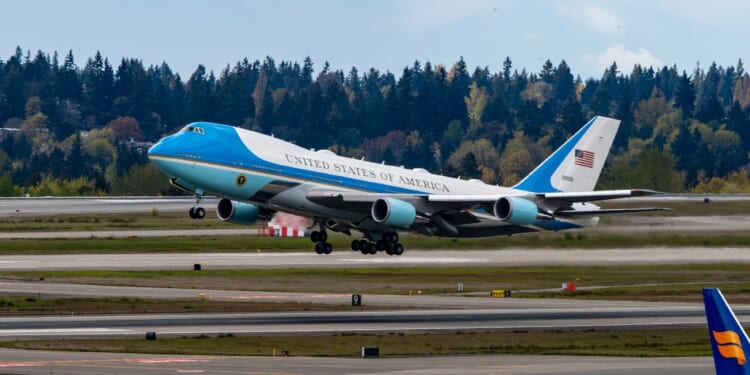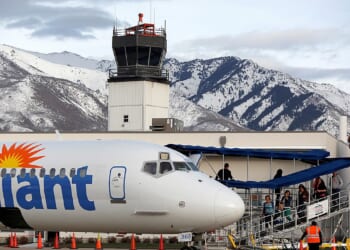The Boeing VC-25A’s public specifications are impressive enough, but much more about the plane’s inner workings remains a closely guarded secret.
From the outside, Air Force One looks like a spit-shined version of the Boeing 747, a wide body commercial jet that any commercial air traveler may well have used at some point—only in the gleaming blue-and-white presidential paint job. But beneath its civilian skin, Air Force One is one of the most heavily modified aircraft ever built: a 747 that is so heavily re-engineered that it has almost nothing in common with the progenitor commercial airliner. Officially designated the VC-25A, the aircraft is a bona fide military platform.
The VC-25A’s (Air Force One) Specifications
Year Introduced: 1990
Number Built: 2 (Tail numbers 28000 and 29000)
Length: 231 ft 10 in (70.67 m)
Wingspan: 195 ft 8 in (59.64 m)
Weight (MTOW): ~833,000 lb (378,000 kg)
Engines: Four Pratt & Whitney JT9D-7R4G2 turbofans (~56,700 lbf each)
Top Speed: ~575 mph (925 km/h)
Range: Unlimited with aerial refueling; ~7,800 nmi (8,976 mi, 14,445 km) unrefueled
Service Ceiling: ~45,000 ft (13,700 m)
Loadout: Secure communications suite, EMP hardening, aerial refueling, defensive countermeasures, medical bay, presidential suite, conference and staff sections
Aircrew: Typically 4 flight crew; up to ~70–100 total personnel (staff, security, press)
What to Know About the VC-25A Presidential Aircraft
The VC-25A first entered service in 1990, while George H.W. Bush was in office. Built on the 747-2008 airframe but extensively customized at Boeing’s Wichita facility, the VC-25A is its own distinct aircraft. For example, while a 747 carries hundreds of passengers, the VC-25A carries fewer than a hundred—staff, Secret Service, press, and of course, the President.
Air Force One’s personnel capacity is so limited because most of the internal space is devoted to communications systems, living quarters, and redundant safety equipment. Even the structure itself was redesigned to survive threats a commercial airliner would (likely) never encounter.
The VC-25A is hardened. Its fuselage and wiring are shielded against electromagnetic pulses (EMPs), ensuring the jet could continue operating even after a nuclear detonation or major cyberattack. Redundant power systems, flight controls, and communication paths mean that even if one network fails, another can immediately take over. The VC-25A can be refueled midair, giving the aircraft unlimited range and the ability to stay aloft for days if necessary. A standard 747, by contrast, must land every few thousand miles and relies on civilian infrastructure for maintenance and support.
Unlike a civilian airliner, the VC-25A features enhanced survivability, thanks to a classified suite of defensive systems, i.e., radar-warning receivers, electronic jammers, infrared countermeasures, and flare and chaff dispensers to confuse incoming missiles. The aircraft’s windows are reinforced, the interior is lightly armored, and the aircraft carries its own environmental and oxygen systems capable of filtering out chemical or biological agents.
We Don’t Know Everything About How Air Force One Works
The aircraft’s cockpit and avionics are also highly specialized. The flight deck houses upgraded navigation, communications, and electronic warfare consoles designed for secure, encrypted links to ground networks and satellites. The pilots—always Air Force officers—fly the VC-25A with hardened instruments that can resist interference from EMPs or jamming. Every single cable, relay, and antenna is reinforced or duplicated—ensuring the jet can maintain contact with the Pentagon, NORAD, and nuclear command authorities in the event of a national crisis.
Still, it is worth noting that these are only the features that have been disclosed to the public. The reality is that many of the aircraft’s features have remained classified, meaning the true aircraft is likely even more capable and survivable than it seems. Advanced features like advanced electronic countermeasures (ECM), stealth-reduction, titanium reinforcement, self-sealing fuel tanks, war room functionality, and so on are all presumed but not confirmed. The aggregate is an aircraft that serves not just a logistical purpose, but as a hardened national command node.
The current Air Force One is nearing retirement. Two additional aircraft, designated VC-25B, are under construction, but have seen repeated delays over the past half-decade. The delays prompted the Trump administration to request—and receive—a similar Boeing 747 from the Qatari royal family. However, that aircraft is not a VC-25, and must now undergo an extensive refit before it can be certified as the new Air Force One.
About the Author: Harrison Kass
Harrison Kass is a senior defense and national security writer at The National Interest. Kass is an attorney and former political candidate who joined the US Air Force as a pilot trainee before being medically discharged. He focuses on military strategy, aerospace, and global security affairs. He holds a JD from the University of Oregon and a master’s in Global Journalism and International Relations from NYU.
Image: Shutterstock / Joe A. Kunzler.


















